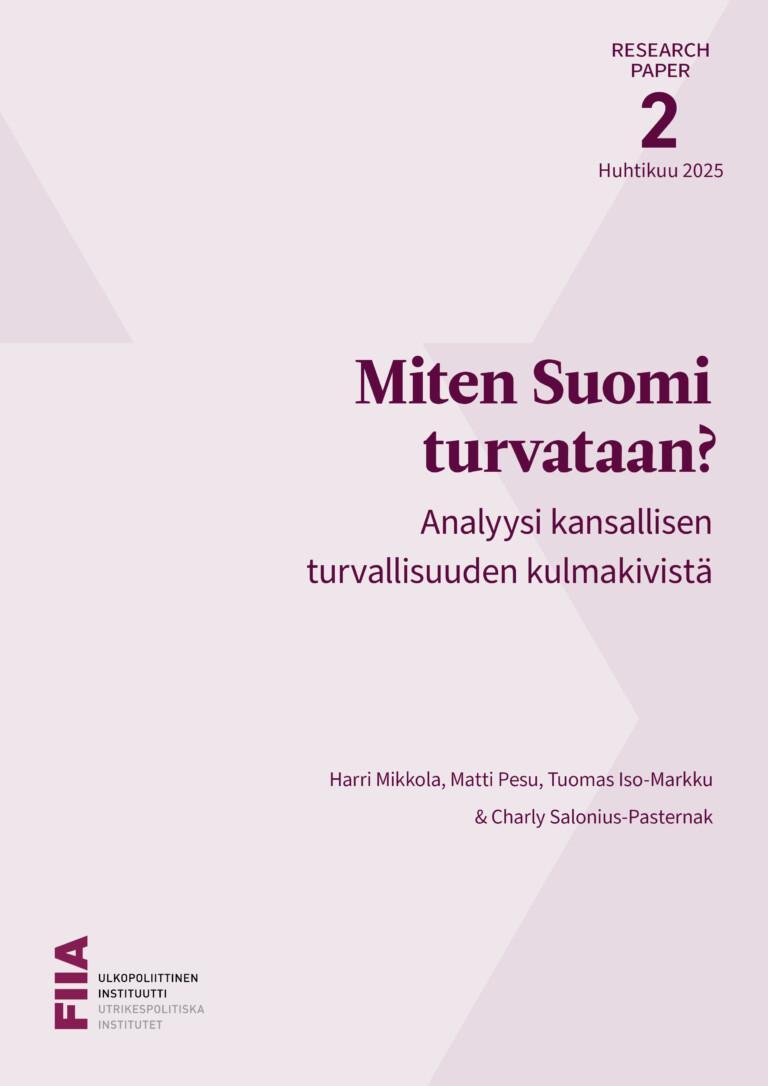
China’s nuclear build-up will make it a nuclear peer adversary of the United States in the 2030s. The US will have to deter both Russia and China, as well as other regional adversaries, with forces geared to engage in one major war at a time.
If two major wars occur either simultaneously or sequentially, US military capability will be put under great stress. In the event of a second war, the US may find itself in a situation of conventional military inferiority, which it might have to compensate for with greater reliance on nuclear weapons.
Since the US remains the ultimate guarantor of European security, its deterrence challenges elsewhere affect European security as well. Thus, even the possibility of war in the Indo-Pacific is a European security issue.
European NATO allies can help mitigate the two-peer problem by permanently taking on a greater share of the burden of Europe’s conventional defence. At the same time, the effectiveness of NATO’s nuclear capability must be enhanced.
A strategic defeat for Russia in the war in Ukraine would postpone Russia’s ability to pose a military threat to Europe. Ukraine’s NATO membership would further serve to reduce the threat of another major war in Europe.
Introduction
The global balance of power is shifting. China has begun a nuclear build-up, unprecedented in its history, which will make it a peer adversary of the United States in the field of nuclear weapons in the 2030s. At the same time, Russia retains the largest and most diverse nuclear arsenal in the world, while North Korea’s growing nuclear forces present an additional deterrence challenge for the US. A serious discussion in the US has consequently emerged about the need for the US to ensure that it is able to deter war both in the European and the Indo-Pacific theatres.[1]
The threat environment in these regions is likely to become more difficult in the late 2020s and in the 2030s, and the deterrence of aggression more complicated. As the US remains the ultimate security guarantor of Europe, its deterrence challenges elsewhere also affect European security. Both the United States and European allies will have to adjust their military posture in order to ensure the credibility of deterrence in Europe and the Indo-Pacific.
This Briefing Paper examines how the two-peer challenge will affect the deterrence dynamics in Europe and the Indo-Pacific. The paper starts with an overview of the fundamentals of ensuring deterrence, before moving on to discuss China’s military build-up and its implications for the US deterrence strategy. It then discusses the coupling of the European and Indo-Pacific security environments and the possibility of the outbreak of simultaneous or sequential major wars. Finally, the paper argues that European NATO allies should respond to the two-peer challenge by making greater investments in their defence.
Requirements of deterrence
Deterrence is based on ensuring that potential aggressors will conclude that the costs of aggression or the escalation of aggression are greater than those of restraint. As states must be able to implement their threats for them to be credible, deterrence is ultimately based on military capability: conventional and nuclear weapons and plans for their use. However, since the target of a deterrent threat is often likewise armed, deterrence becomes not only a contest of military power but also a battle of wills.
The challenge, as eminent deterrence theorist Thomas Schelling pointed out, is how to make deterrent threats persuasive. If one nuclear weapon state signals to another that it is ready to defend itself with nuclear weapons, the state will also communicate that it is ready to accept the risk of nuclear retaliation. Thus, nuclear threats are credible only in extreme circumstances.[2] States must therefore be able to fight the war at a conventional level for as long as possible. The ability to do so also acts as a major deterrent against nuclear war, given that the use of nuclear weapons would highly likely occur only if a conventional war was already in progress. As noted by Michael Quinlan, if combatants fail to achieve their goals at one level, they may explore alternative options at another level, unless deterred. For this reason, various levels of capabilities are complementary and interdependent. They all contribute to deterrence.[3] Those unable to maintain robust non-nuclear military capability face two problems: they have to rely more on nuclear capability but, at the same time, their deterrent threats face credibility issues in less than extreme situations.
For most of the Cold War, NATO addressed this problem by basing its deterrence and defence strategy on the concept of flexible response: conventional forces were to bear the brunt of the initial attack, while nuclear forces were to ensure that the threat of nuclear escalation could be used either to deter escalation of the war, or to terminate it. Commenting on NATO’s doctrine during the Cold War, Quinlan noted that “deterrence required making it as hard as possible for any adversary to form the view that NATO would shrink from decisions on raising the conflict's intensity, or to dare act on such a view. The range of options available must therefore be an unmistakable continuum without huge gaps”. Diverse conventional and nuclear forces were needed to make deterrence effective.[4] Ultimately, the strategy was based on the principles outlined by Carl von Clausewitz: by including an implicit threat of nuclear escalation, NATO ensured that aggression of any kind against it could not be a rational continuation of Soviet policy by other means.[5]
However, given the conventional superiority of the Warsaw Pact, the prospects of NATO avoiding the use of nuclear weapons would have been slim if war had broken out between NATO and the Warsaw Pact. Since the end of the Cold War, the outlook has been better. NATO no longer has to reckon with the military might of the USSR and the Warsaw Pact. Instead, US military power allows NATO to enjoy conventional superiority over Russia. The alliance can be more confident of success during the conventional phase of war. This includes caveats, however, since Russia enjoys military superiority over individual allies, allowing its conventional forces to threaten their existence. Nonetheless, since the Cold War, NATO has been able to downgrade its reliance on nuclear deterrence.
China’s conventional and nuclear build-up complicates the success of NATO’s strategy in both the nuclear and the conventional realm: 1) instead of only one, US nuclear forces will have to deter two nuclear peers in the 2030s, and 2) China’s increasing conventional military power will necessitate an increased US presence in the Indo-Pacific. Both factors will strain US resources.
The two-peer challenge
The current US nuclear arsenal consists of about 1,800 deployed strategic nuclear warheads and about 200 non-strategic nuclear weapons. The size of the arsenal is based on the limits imposed by the 2011 New START arms control treaty, where the US negotiation position was based on the targeting requirements of the US Strategic Command. These requirements were overwhelmingly based on Russia’s capabilities, particularly its nuclear forces, in line with the US targeting strategy, which focuses on the adversary’s military capability. China possessed around 200 nuclear warheads, a few dozen of which could reach the continental US. This force could be factored into US strategic plans without much difficulty. The US stockpile is also estimated to include about 2,000 warheads held in reserve, but these are not operationally available as long as New START remains in force.
Until the 2010s, China was content to maintain a small nuclear arsenal, which facilitated a credible assured retaliation posture, a strategy whereby China would retaliate to the use of nuclear weapons by counterattacking with its own weapons. As an instrument of nuclear blackmail, however, the arsenal was too limited to be credible. At the same time, China engaged in modernization and expansion of its conventional forces, a process that was accelerated during Chairman Xi Jinping’s rule.
Starting from the late 2010s, China’s military build-up was extended to its nuclear forces. The scale of the build-up was revealed in 2021 when satellite imagery showed the ongoing construction of three massive Intercontinental Ballistic Missile (ICBM) silo fields. When the new silo fields reach full operational capability, China will have the largest ICBM force in the world. Additionally, China is manufacturing modern ballistic missile submarines (SSBN) that will operate concurrently with its legacy SSBNs. It has an ongoing stealth bomber programme and has tested a fractional orbital bombardment system. Currently, the US estimates that China possesses more than 500 operational nuclear warheads. The expansion is expected to continue rapidly until 2030, when China is estimated to possess around 1,000 nuclear warheads, and well into the 2030s. The recently uncovered cases of corruption in the construction of the silo fields will likely only slow down the process.[6] The decision to bulk up the nuclear arsenal has, after all, already been made.
The quantitative leap in China’s nuclear capability is accompanied by a qualitative one. First, China is building an early-warning and command and control system that will make its strategic nuclear forces more survivable and responsive. Second, it has a growing arsenal of precision-guided nuclear-capable missiles, some of which may later be armed with lower-yield nuclear warheads, which the US assesses may be under development. This would provide China with more proportional nuclear employment options.[7]
Consequently, China’s nuclear and conventional military build-up will likely eventually result in the capability to adopt a credible flexible response strategy, which it can also utilize coercively in a conflict in the Indo-Pacific, much like Russia has engaged in nuclear blackmail during the war in Ukraine. The situation is further complicated by North Korea’s growing nuclear forces and its possible access to Russian military technology in exchange for its recent decision to provide military aid to Russia.
Meanwhile, Russia’s nuclear forces are the largest and most diversified in the world. Besides strategic nuclear forces comparable to those of the US, Russian nuclear forces are estimated to include an arsenal of around 2,000 non-strategic nuclear weapons, including ballistic and cruise missiles, gravity bombs, torpedoes, and depth charges.
Russia’s losses during the war in Ukraine are likely to lead it to rely more on its nuclear deterrence in the short to mid-term. However, this reliance is borne of necessity rather than desire. Once it is able to do so, Russia is likely to repeat the process of the 2010s, when it rebuilt and reformed its conventional forces in order to attain the military power that it unleashed against Ukraine in 2014 and 2022. Although the dynamics of the war in Ukraine will determine Russia’s military posture in the near term, Russia is unlikely to downsize its nuclear forces in the long term. President Putin recently pointed out that Russia’s superiority in theatre nuclear capability over NATO is a competitive advantage that it does not intend to give up.[8] One possible outcome may therefore be a replenished and battle-hardened conventional military supported by a more powerful nuclear posture.
As a consequence, the US will have to deter two major nuclear powers plus North Korea, with a nuclear posture that was initially designed for deterring primarily one. China’s military build-up will also necessitate more US investments in the defence of its Indo-Pacific allies. In extreme crisis situations, the ability of the US to maintain a range of options that form “an unmistakeable continuum without huge gaps” might come under stress. Furthermore, the prevention and prosecution of war will become more difficult in this situation because the possible pathways to war, and circumstances in which wars are fought, become more complex.
Opportunistic aggression
As the US is the ultimate security guarantor of its allies both in Europe and in the Indo-Pacific, the security environments of these regions are linked. Aggression in the Indo-Pacific would have an impact on the security of Europe and vice versa. The situation is problematic for the US because its military is geared to engage in only one major war at a time.[9]
In the event of a second conflict, the US will have to prioritize the use of its assets and allocate its military capabilities to both theatres. This may lead to uncomfortable trade-offs, particularly regarding military assets that are in short supply, such as advanced conventional munitions. This, in turn, might even result in US conventional inferiority in the second conflict, which it might have to compensate for by relying on its nuclear deterrent, a situation it has sought to avoid since the early 1960s.
In the future, conflict scenarios will become more complex because they will be greatly affected by what happens in the other theatre. Wars might break out simultaneously or they might be sequential. In the first case, military forces would be spread thin. In the second case, the war would have to be fought with attrited military forces. Moreover, if the conflicts were simultaneous, the aggressors might coordinate their actions. Aggression might be more successful in one theatre than the other. Strategic attacks or the use of weapons of mass destruction might occur in one conflict or both, simultaneously or sequentially.
While most experts assume that it is unlikely that Russia and China would cooperate on such issues, defence planning cannot proceed from the assumption that it is out of the question. Military procurement takes such a long time that the decisions taken to build the force of the 2030s must be made today. Ten years is a blink of an eye in the procurement process, but not in international politics. One need only point to the threat environment and the international balance of power in 2012 compared to 2022.
Even a single war is more problematic for the US in the two-peer threat environment because it would have to hold greater military capability in reserve in order to deter the second adversary from initiating ‘opportunistic’ aggression. While war may not initially be the preferred foreign policy instrument of one potential adversary, a conflict started by another adversary would be a major drain on US resources. The second adversary might then exploit the new-found window of opportunity in the second theatre and advance its political goals with military force.
Furthermore, the window of vulnerability caused by one major war might last for years. A recent analysis based on wargaming the notional Chinese invasion of Taiwan in 2026 concluded that even if the defence of Taiwan was ultimately successful, the US would face major losses in all outcomes. As the US has only two shipyards that build large surface combatants, it would not be able to replace lost naval assets for decades while continuing its current build programme. Replacing lost aircraft would also take several years in more destructive outcomes. The fighting in a major war might also last for years.[10] Both the production capacity and attention of the US would then be focused on sustaining its campaign in the Indo-Pacific. In extreme circumstances, the war might result in the attrition of the US nuclear forces, which would impact the nuclear balance between the US and Russia.
Even if peace was in the national interests of the second adversary at the outset of the first war, the permanence of these interests is not guaranteed. The outbreak of the Israel-Hamas war, one and a half years after Russia’s invasion of Ukraine, is only one example of how new conflicts can emerge after the outbreak of the first one, and how they might impact the first war. In aiding Ukraine, the US will now have to consider how it can do so while ensuring that it can continue to support Israel. The war has also forced the US to devote some of its attention to deterring the outbreak of a regional conflict in the Middle East. The current impact of the war in Ukraine, significant as it is, would be dwarfed by the outbreak of a second major war while one was already in progress.
The two-peer problem is, however, mitigated by the fact that the US force requirements are different in Europe and in the Indo-Pacific region. War in the Indo-Pacific would be particularly intensive on naval assets, while war in Europe would be most demanding on ground forces. However, the US depends on its airlift and sealift capability to reinforce both regions. If these assets were significantly weakened due to a war in Asia, the US capability to reinforce in Europe could be less than expected. Moreover, because certain precision-guided munitions would be expended at a great rate in the first war, they might not be available in Europe in the expected quantities, or even at all. Consequently, even the possibility of war in the Indo-Pacific is inevitably a European security issue, and will therefore also require solutions from Europe.
The European response
While only the US can resolve the challenges related to its strategic posture, European NATO allies can and should take the initiative to enhance their collective security. To address the problems of the two-peer environment and avoid the possibility that NATO might have to increase its reliance on nuclear weapons, European allies should permanently take greater responsibility for their conventional defence. At the same time, to strengthen the credibility of NATO’s nuclear capability in situations where US nuclear forces are attrited, the capability based on forward-deployed nuclear weapons should be made more effective by making exercises more realistic and integrating them with conventional ones. Further, their survivability should be enhanced by developing infrastructure.
European allies have traditionally been wary of any initiatives that could reduce the US burden in the defence of Europe. Besides its military value, US military presence has had great political value because it ensures that US national interests are always at stake should war break out in Europe. Thus, US capability has often been equated with US commitment. More of each has usually been preferred, which has resulted in Europe becoming dependent on the US. However, in a threat environment where the US might have to engage in a major war elsewhere, such dependency can become dangerous, because in extreme situations the capability might come under stress even if the commitment was there.
It is therefore in the national interests of European allies to share the burden more evenly and, as one expert recently pointed out, the US request for Europe to do so should not be seen as reduced US commitment to Europe’s defence.[11] On the contrary, by providing more conventional military capability, European allies will help the US to maintain its commitment to NATO by reducing the likelihood that it will need to rely on nuclear weapons to do so. What is required from Europe is a significantly more powerful conventional force and a European military industry capable of sustaining high-intensity warfare at the level it is being conducted in Ukraine.
At the same time, the possibility that US nuclear forces might have to be employed in another conflict also raises the value of the nuclear weapons based in Europe and NATO’s adaptive planning capability. While US nuclear weapons on European soil retain their political value in ensuring that the transatlantic link remains unbroken, the military value of forward-deployed nuclear weapons will also increase in the two-peer threat environment. These weapons are earmarked for the defence of Europe and would not be attrited in a war in the Indo-Pacific. Accordingly, ensuring the credibility and effectiveness of the collective deterrent will become more important in the future. This should at least entail more realistic exercises with tighter conventional and nuclear integration, and more flexibility in terms of the support infrastructure. It might also entail the US procuring a new theatre capability for itself, such as the nuclear-tipped submarine-launched cruise missile, to reduce Russia’s superiority in non-strategic nuclear weapons. The bottom line, however, is that European allies themselves must become active in developing NATO’s deterrent posture to meet the requirements of the new era.[12]
The two-peer threat environment can also be made more manageable by inflicting a strategic defeat on Russia in the war in Ukraine. Supporting Ukraine’s defensive effort will attrit Russia’s forces and postpone its ability to pose a direct military threat to NATO. Building up the European military industry for the purpose of aiding Ukraine will also result in the capability to maintain more powerful conventional forces in Europe.
Finally, Ukraine’s NATO membership would result in a massive improvement in the conventional military capability of NATO, and prevent Russia from focusing its military power on one flank of the alliance without exposing itself on the other. What is more, the likeliest target of opportunistic aggression in Europe is not a NATO ally, but Ukraine or another country that is not a treaty ally of the US. While Russia could expect the US to commit to defending European allies even if the US was engaged in a war in the Indo-Pacific, the chances of Ukraine receiving military aid on the scale it has since 2022 would be close to zero in the same situation. Thus, Ukraine’s NATO membership will be crucial for maintaining peace in Europe.
Conclusions
A sound deterrence policy is long-term in nature, seeking to shape adversary behaviour and foster conditions conducive to preventing war. While certain long-term scenarios appear unlikely, taking them into account will make them even less so. Adversaries must always understand that hostile actions are likely to be unsuccessful and dangerous for them, which will foster restraint and a grudging acceptance of the status quo.
Thus, European NATO allies will not only have to contemplate the old question of credibility when it comes to US commitments; for the first time since the inception of NATO, they will also have to consider how to ensure that the US has the capability to actually meet its commitments. Ultimately, Europe’s deterrence and defence can be made robust enough by strengthening NATO’s nuclear capability, and enhancing the military posture and military-industrial capacity of the European allies.
Endnotes
[1] Lawrence Livermore National Laboratory (2023) China’s Emergence as a Second Nuclear Peer: Implications for U.S. Nuclear Deterrence Strategy. CGSR Study Group Report, https://cgsr.llnl.gov/content/assets/docs/CGSR_Two_Peer_230314.pdf; House of Representatives Armed Services Committee (2023) America’s Strategic Posture: The final report of the congressional commission on the strategic posture of the United States, https://armedservices.house.gov/sites/republicans.armedservices.house.gov/files/Strategic-Posture-Committee-Report-Final.pdf.
[2] Schelling, Thomas (2020 [1966]) Arms and Influence, Yale University Press, New Haven and London, p. 35.
[3] Quinlan, Michael (1997) Thinking About Nuclear Weapons. Whitehall Paper 41, RUSI, https://fisherp.scripts.mit.edu/wordpress//data/wordpress/htdocs/wp-content/uploads/2017/03/Thinking-about-Nuclear-Weapons-RUSI-WHP41_QUINLAN1.pdf; see also Biddle, Tami Davis (2020) “Coercion Theory: A Basic Introduction for Practitioners”, Texas National Security Review, Vol 3(2), 94–109, https://tnsr.org/2020/02/coercion-theory-a-basic-introduction-for-practitioners/.
[4] Quinlan 1997, pp. 14–15.
[5] von Clausewitz, Carl (1873), On War. London: N. Trübner, https://clausewitzstudies.org/readings/OnWar1873/TOC.htm.
[6] Martin, Peter and Jennifer Jacobs (2024) “US Intelligence Shows Flawed China Missiles Led Xi to Purge Army”, Bloomberg, 6 Jan 2024, https://www.bloomberg.com/news/articles/2024-01-06/us-intelligence-shows-flawed-china-missiles-led-xi-jinping-to-purge-military.
[7] U.S. Department of Defense (2023) Military and Security developments involving the People’s Republic of China. Annual report to Congress, https://media.defense.gov/2023/Oct/19/2003323409/-1/-1/1/2023-MILITARY-AND-SECURITY-DEVELOPMENTS-INVOLVING-THE-PEOPLES-REPUBLIC-OF-CHINA.PDF, pp. 103–113; Lawrence Livermore National Laboratory, p. 13.
[8] President of Russia (2023) “Plenary session of the St Petersburg International Economic Forum”, http://en.kremlin.ru/events/president/news/71445.
[9] Lawrence Livermore National Laboratory. This section draws heavily on the analysis conducted by the study group.
[10] Cancian, Mark, Matthew Cancian & Eric Heginbotham (2023) The first battle of the next war: wargaming a Chinese invasion of Taiwan. A Report of the CSIS International Security Program, https://www.csis.org/analysis/first-battle-next-war-wargaming-chinese-invasion-taiwan, pp. 143–144.
[11] Weaver, Gregory (2023) “The urgent imperative to maintain NATO’s nuclear deterrence”, NATO Review, https://www.nato.int/docu/review/articles/2023/09/29/the-urgent-imperative-to-maintain-natos-nuclear-deterrence/index.html.
[12] See e.g., Kacprzyk, Artur (2023) NATO Nuclear Adaptation: Rationales for expanding the force posture in Europe, PISM Report, The Polish Institute of International Affairs, https://www.pism.pl/publications/nato-nuclear-adaptation-rationales-for-expanding-the-force-posture-in-europe.










